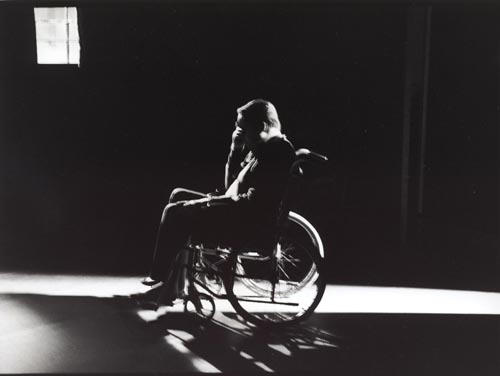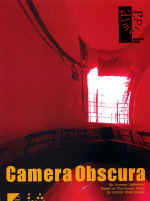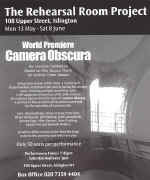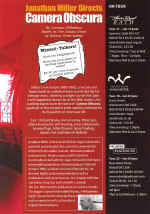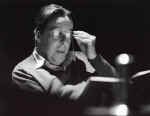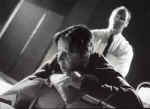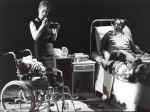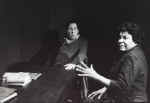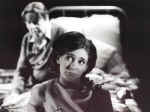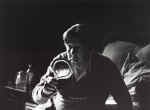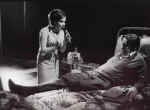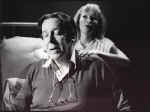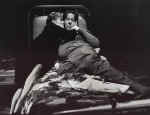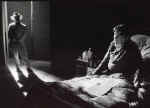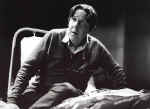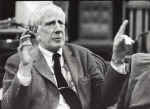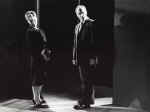click here to visit Lorenzo DeStefano the web site
"CAMERA OBSCURA" by Lorenzo DeStefano Almeida Theatre, London May 13-June 8, 2002
|

The turtle, the librarian and the Barbie dolls The life of a demented and bigoted hypochondriac provides Jonathan Miller with an unlikely triumph. But hurry - only 55 of you can see it at a time Kate Kellaway Sunday May 26, 2002 Camera Obscura
Almeida rehearsal rooms, London N1 Was his mighty tome his tomb? He yearned for
publication, perhaps as a projected end to loneliness. He sought young
women, too. He would advertise for them to read and talk to him - and
would fondle or sometimes have sex with them - and record this as
compulsively as he did everything else. He kept his diaries between
1918 and 1963, the year he shot himself.
On
the face of it, this would not seem like a subject for a play: static,
verbose, disagreeable. But Camera Obscura is a fantastic It is out of the ordinary in every way. For a start,
it is being performed in the Almeida's rehearsal rooms which seat only
55 people. This almost removes the sense of being at the theatre;
there is, instead, a feeling of disquieting involvement.
We are in the dark, watching occasional, forbidden
light (Inman abhored the sun) falling across a room that, at times,
recalls an Edward Hopper interior, complete with an atmosphere of
tense irresolution. The unexpectedly robust pleasure of the evening is
in trying to make sense of Inman's psychology.
Evelyn
(Diana Hardcastle) is as hard to fathom as he is. She looks like an
elegant, sauntering librarian, dressed in black, as if registering her
husband's living death (after his suicide, she switches to cream). She
is a fashion plate, a bemusing combination of infidelity and devotion.
Inman has a harsh, comic instinct, telling her at one point: 'You look
like you're getting all your exercise writing cheques.'
Other visitors come and go, like flies alighting on a
decaying fruit. His interest, he more than once maintains, is in the
hidden and the unseen. This becomes our concern, too, as we consider
him in darkness and in a posthumous limelight.
Camera Obscura, The Almeida Rehearsal Room, LondonIn bed with Arthur InmanReview by Paul Taylor27 May 2002
The show is based on the real-life diaries of Arthur
Crew Inman (1895-1963), a moneyed American who made a kind of art form
of his phobias (to light, noise, John F Kennedy etc) and took the
principle The photo of a testy-looking, toothbrush-moustached
Inman in the programme suggests a peppery, wired-up individual.
Eschewing impersonation, Peter Eyre converts the character into a great
tragicomic creation, his Yet the play and the performance help you to see why so
many people remained loyal to him – not least his wife, whose
oscillation between exasperated affection and the desperate desire for
some freedom and dignity is beautifully captured by Diana Hardcastle.
The hypochondriac's gently insistent air of total entitlement would very
quickly, you feel, enslave anyone without his paradoxical strength of
character. But that manner covers a terrible The play is shaped in the life-in-the-day-of format, and
it happens to be the day, in 1963, on which he took his own life. The
consequences of his warped manner of existence crowd in on him. Through
a succession of encounters, which the expert shading of Jonathan
Miller's production prevents from ever feeling like a desultory straggle
of And yet this failed artist, this Proust without the excuse of a great novel, left a vast literary legacy: 17 million words in 155 volumes of diaries. It can only be a compliment to the play, production and cast that they have left me avid to get hold of the published extracts. To 8 June (020-7359 4404) 
Diary of a nobody How did a housebound hypochondriac write a 17 million-word journal? And why has Lorenzo DeStefano turned it into a play? Lorenzo DeStefano Wednesday May 8, 2002 I first encountered the 17 million-word diary of this
transplanted resident of Boston in 1985, the year Harvard University Covering the years 1903-63, Inman's social observations
range from his favourite subject, the American civil war, through the
onset of the nuclear age up to the assassination of John F Kennedy. It
becomes clear early on that this failed romantic poet meant these vast
outpourings to ensure him the kind of literary fame that eluded him during
his sleepless days and nights in apartment 604 at Garrison Hall, the
building he hardly left for 50 years. His desire for the spotlight rears
its head throughout the diary.
"I wish there was a way I could know right now
whether it's been worth the immense effort and nervous perseverance I've
spent trying to maintain the highest quality of this work, its honesty. If
the diaries of Pepys, Casanova, Boswell and Rousseau have proven of
interest to future generations, why not mine?"
Instead of the self-centred epic of the mind that it
threatens to become, the work is radically transformed by the people
Arthur met after moving to Boston in November 1919. By placing personal
ads in the city's papers for over 40 years, he reached well beyond the
confines of apartment 604 to a surprisingly diverse and fascinating range
of fellow humans.
"Wanted: Talkers & Readers - Have you
imagination? Can you read or talk rapidly and interestingly? Have you had
unusual, dramatic or exciting experiences? $5.00 per hour to amuse an
invalid author (more if your speech is superlative)."
By including the hopes and dreams of the anonymous
shopgirls and clerks and travelling salesmen who responded to "At last count I have chronicled the lives of more
than 1,000 people within these pages. They are not what you'd call great
people. For the most part they are of the common, everyday variety. Yet
they are far more interesting to me than persons of wealth or so-called
"class"."
By pursuing his passion for recording the passage of time,
Inman meant to ensure not only himself but these fellow citizens a measure
of the immortality he felt they all deserved. Of course, the diary's
eventual publication 22 years after his death was nothing but a distant
hope throughout his long, unquiet life.
"I wish to explain, in the unlikely case that this
diary should ever be deemed to amount to more than the paper it is put
upon, the broad theory of its organisation... I delve back into my past
and set down all the odds and ends I can remember, so that in the fullness
of time I shall have painted the parts of a connected frieze, parts of
which you, dear readers of the future, will have to put together."
Inman spared no one his poisoned pen, even his wife of 40
years, Evelyn Yates Inman. She emerges, for me, as one of the great female
figures in contemporary non-fiction. Her long-suffering role of nursemaid,
cajoler, co-conspirator and loyal friend to her ill-chosen man brings to
the diary a much-needed domestic reality without which it would lose much
of its appeal. Arthur's opinion of her, alternately scornful and full of
praise, chronicles one of the most strangely functional marriages, real or
imagined, ever set down on paper.
When Evelyn showed Arthur love, performed some useful
function for him or simply accepted him for the difficult but lovable
creature he had become, his views on her changed.
"Ambivalence aside, Evelyn is the sweetest child in
all the world. I am, in fact, of the humble opinion that my wife is a
treasure among treasures, the hub of the wheel of my existence. I guess I
love her more than I had any idea. Admitting it is not unlike having a
tooth pulled. Funny thing, love."
After beginning a correspondence with Aaron in the
mid-1980s, I slowly began to see the dramatic potential hidden in the
elephantine folds of the diary. After several years of spadework, writing
outline after outline to try to create some definable storyline, in the
mid-90s I had to actually tackle the job. By chance I came upon the idea
of setting the play during the last few days of Inman's life. Hanging this
vast memory piece on some kind of structure seemed essential to keep the
attention of an audience, for whom Arthur's taciturn nature and outrageous
opinions might be enough to drive them from their seats. Likewise, any
attempt to oversanitise the man would be to ignore one of Arthur's most
strenuous demands of any "editor of the future". "One day you will know my world more intimately than
you do your own, will have mapped its texture, its Chinese box
construction. Should you choose to emphasize my whiny, rotten qualities,
so be it. If I am made out as some kind of genius of solitude, I will
likewise go along. But if you attempt to nicen me up I will come back as a
ghost and seek revenge on you as one who has cheated me of my rightful
place in history."
· Camera Obscura is at the Almeida Rehearsal Room,
London N1, from Monday. Box office: 020-7359 4404. |
| photography by Ivan Kuncl |
|
For the Guardian Online article "DIARY OF A NOBODY" by Lorenzo
DeStefano, click
here For the London Observer review "The turtle, the librarian and the Barbie Dolls", click here For the London Independent reviews "In Bed with Arthur Inman", click here For the British Medical Journal review, click here |
